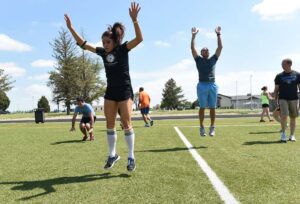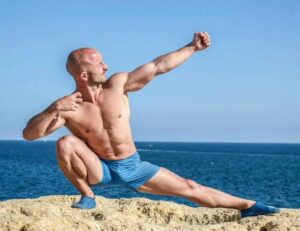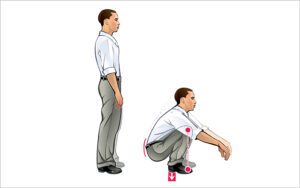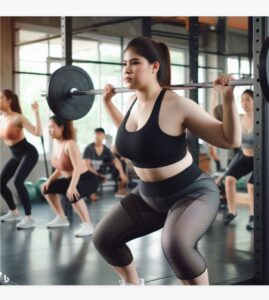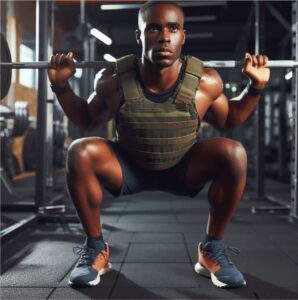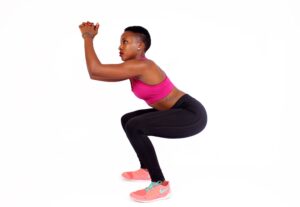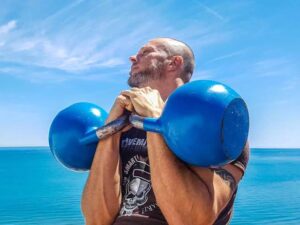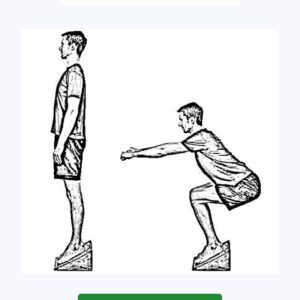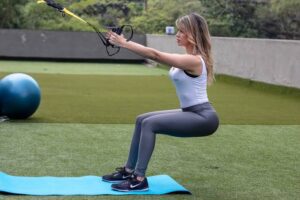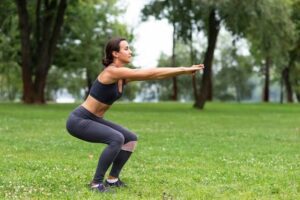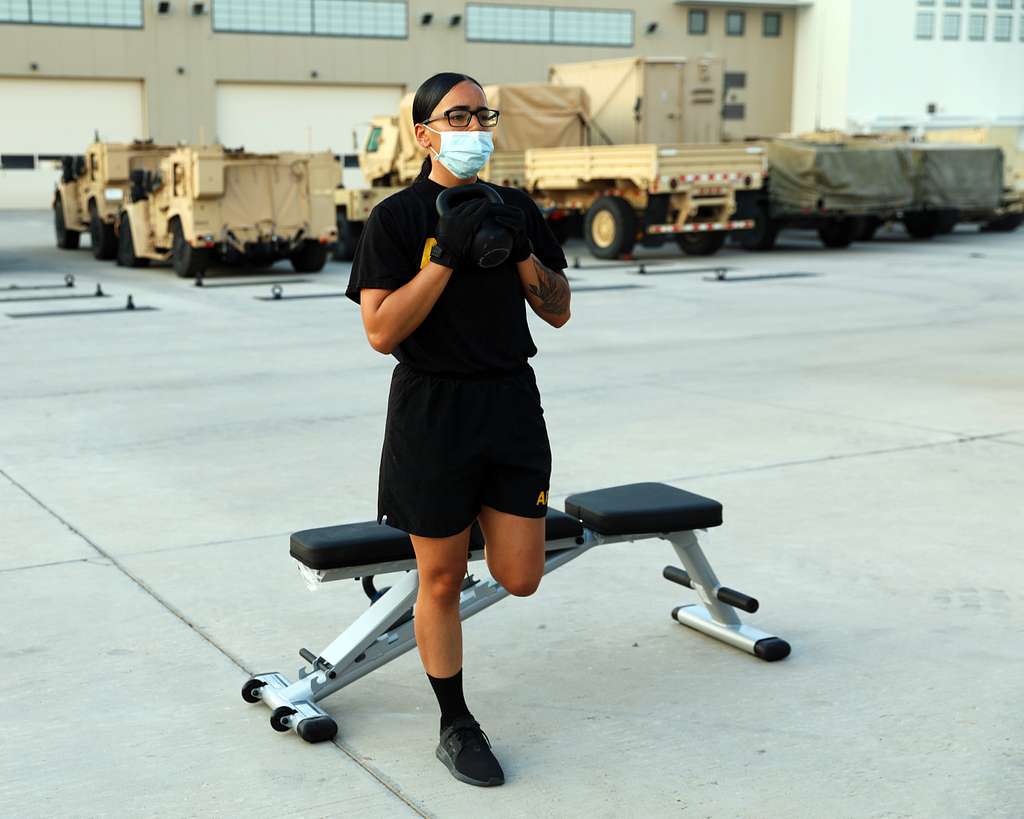
Split squats are a powerful lower body exercise that can deliver a wide range of benefits for your strength, stability, and overall fitness.
Whether you’re an athlete looking to enhance performance or a fitness enthusiast seeking to tone and strengthen your legs, split squats are a fantastic addition to your workout routine.
Let’s explore the incredible benefits of incorporating split squats into your training and provide you with a step by step guide on how to do split squats correctly to reap it’s remarkable benefits as well as tips to optimize split squats benefits.
What Are The Benefits of Split Squats?
The benefits of split squats are:
- Increased Lower Body Strength
- Improved Balance and Stability
- Enhanced Core Engagement
- Reduced Risk of Knee Injuries
- Unloading the Spine
- Improved Hip and Quad Mobility
- Versatility and Accessibility
- Muscle Pump and Aesthetics
- Athletic Performance
- Increased Muscle Mass and Endurance
We will explain each of these 10 incredible benefits of split squats, how they provides these benefits and the importance of each of these amazing benefits of split squats in our everyday life.
1. Increased Lower Body Strength:
How it Provides This Benefit: Split squats place a significant load on the quadriceps, hamstrings, and glutes, fostering muscular activation and hypertrophy. The exercise involves a unilateral movement, requiring each leg to support the body independently.
This targeted approach ensures a more comprehensive recruitment of lower body muscle fibers, contributing to increased strength over time.
Importance of This Benefit: Enhanced lower body strength is foundational for various everyday activities. From climbing stairs to lifting groceries, lower body strength plays a crucial role in maintaining mobility and independence.
Additionally, for athletes engaged in sports requiring explosive leg power, such as sprinting or jumping, increased strength is directly correlated with improved performance.
2. Improved Balance and Stability:

How it Provides This Benefit: Split squats demand a high degree of balance and stability, as the exercise involves maintaining a controlled posture while performing a dynamic movement.
The unilateral nature of the exercise activates stabilizer muscles, challenging the body to maintain equilibrium.
Importance of This Benefit: Balance and stability are integral components of daily life. Walking, standing, and even sitting require a level of stability.
By enhancing these aspects through exercises like split squats, individuals can reduce the risk of falls and injuries, particularly important for older adults. Additionally, improved balance contributes to better coordination, enhancing overall movement efficiency.
3. Enhanced Core Engagement:
How it Provides This Benefit: Split squats necessitate continuous core engagement to stabilize the torso during the movement. The core muscles, including the abdominals and obliques, work to maintain proper posture and prevent excessive leaning or rotation.
Importance of This Benefit: A strong and engaged core is more than just aesthetically pleasing—it is the cornerstone of overall stability and spinal support.
In everyday life, from lifting objects to bending down, a robust core reduces the risk of lower back pain and improves overall functional movement. Whether sitting at a desk or participating in recreational activities, core strength is fundamental for maintaining a healthy and pain-free back.
4. Reduced Risk of Knee Injuries:
How it Provides This Benefit: Split squats promote proper posture and alignment, particularly concerning the knees. The controlled descent and ascent of the movement ensure that the knee joint maintains a stable trajectory without excessive stress or misalignment.
Importance of This Benefit: Knee injuries, such as patellofemoral pain syndrome and patellar tendinitis, can be debilitating and often result from poor biomechanics or overuse.
By emphasizing correct form in exercises like split squats, individuals can mitigate the risk of these injuries. Healthy knees are crucial for maintaining an active lifestyle and preventing chronic pain that can hinder daily activities.
5. Unloading the Spine:
How it Provides This Benefit: Split squats are a unilateral exercise that involves a split stance, inherently reducing the axial load on the spine.
Unlike bilateral exercises like back squats, where a barbell is loaded on the shoulders, Bulgarian split squats distribute the load across each leg, unloading the spine.
Importance of This Benefit: For individuals with back issues or discomfort, unloading the spine is a game-changer. The exercise provides an avenue for lower body strengthening without exacerbating spinal issues.
This is particularly relevant in a society where sedentary behaviors and desk-bound jobs contribute to back problems. Bulgarian split squats offer a safer alternative for those seeking lower body strength while minimizing spinal stress.
6. Improved Hip and Quad Mobility:
How it Provides This Benefit: Split squats demand a deep squatting motion, requiring substantial flexion in the hip and knee joints.
This dynamic movement pattern enhances flexibility in the hip flexors, quadriceps, and surrounding muscles. The unilateral nature of the exercise ensures both sides of the body are equally challenged, addressing potential asymmetries in mobility.
Importance of This Benefit: Improved hip and quad mobility are crucial for preventing movement restrictions and maintaining a healthy range of motion.
In daily life, activities like bending, squatting, and lunging become more fluid and less strenuous with enhanced mobility. Addressing asymmetries reduces the risk of imbalances and potential injuries associated with restricted movement patterns.
7. Versatility and Accessibility:
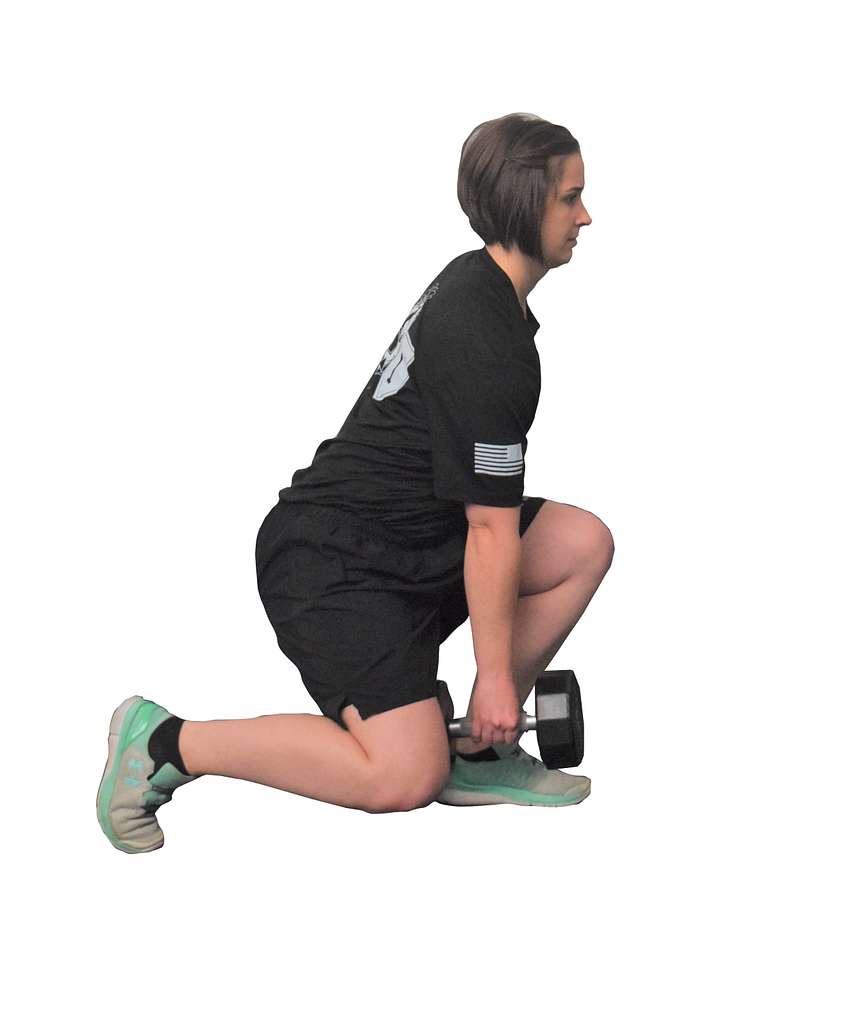
How it Provides This Benefit: Split squats stand out for their versatility and accessibility. The exercise can be performed with minimal equipment, making it adaptable to various environments.
Additionally, it accommodates different fitness levels, as the intensity can be adjusted by altering body positioning or adding external resistance.
Importance of This Benefit: Versatile and accessible exercises facilitate consistent physical activity, irrespective of one’s location or fitness level. The convenience of performing split squats anywhere, whether at home or outdoors, encourages individuals to incorporate them into their routine, promoting a sustainable and adaptable approach to fitness.
8. Muscle Pump and Aesthetics:
How it Provides This Benefit: Executing split squats with sufficient intensity induces a muscle pump in the targeted lower body muscles, particularly the quadriceps, hamstrings, and glutes.
This temporary increase in muscle size and vascularity contributes to improved aesthetics, showcasing enhanced muscle definition and tone.
Importance of This Benefit: Beyond the functional aspects of exercise, the aesthetic component can be a powerful motivator. Achieving a muscle pump provides visual feedback, fostering a sense of accomplishment and dedication to one’s fitness journey. While aesthetics vary individually, this aspect can positively influence adherence to a workout routine.
9. Athletic Performance:
How it Provides This Benefit: Split squats simulate the unilateral movements and muscle engagement required in various athletic activities.
This exercise enhances lower body strength, power, and stability, translating well to sports like running, cycling, and other endurance activities. The targeted muscle engagement supports the specific demands of athletic performance.
Importance of This Benefit: Athletes, whether professional or recreational, benefit from exercises that mimic the demands of their chosen sport.
Split squats contribute to improved athletic performance by strengthening muscles crucial for activities that demand lower body strength and endurance, ultimately enhancing an individual’s ability to excel in their chosen athletic pursuits.
10. Increased Muscle Mass and Endurance:
How it Provides This Benefit: Split squats, when incorporated into a comprehensive training program, stimulate muscle growth through resistance and repetition.
The exercise challenges the lower body muscles, leading to increased muscle mass. Simultaneously, the repetitive nature of the movement improves muscular endurance, enabling the muscles to sustain effort over extended periods.
Importance of This Benefit: The versatility of split squats makes them adaptable to diverse training goals. Increased muscle mass contributes to overall strength, supporting various physical activities.
Improved muscular endurance is valuable for activities requiring prolonged effort, from everyday tasks to more demanding physical pursuits. This dual benefit enhances an individual’s capacity for both strength and endurance, fostering a well-rounded fitness profile.
In summary, Split squats offer a multifaceted approach to enhancing lower body strength, stability, and overall well-being. These benefits extend beyond the gym, positively impacting daily activities and reducing the risk of injuries. Whether you’re aiming for improved athletic performance or simply seeking a more functional and pain-free lifestyle, incorporating Bulgarian split squats into your fitness routine can be a valuable investment in your health.
How To correctly do Split Squat and Reap These Benefits
Performing split squats correctly is crucial to reap the associated benefits while minimizing the risk of injury. Here’s a step-by-step guide on how to perform split squats with proper form:
Split Squat Technique:
Starting Position:
- Begin by standing with your feet hip-width apart.
- Take a step forward with one foot, ensuring a comfortable and stable stance.
- The back foot should be positioned behind, with the ball of the foot on the ground and the heel lifted.
Alignment:
- Ensure that your front knee is directly above your ankle, forming a 90-degree angle.
- Keep your back knee bent, hovering just above the ground.
Posture:
- Maintain an upright torso with your chest lifted and shoulders back.
- Engage your core muscles to stabilize your spine.
Descent:
- Lower your body by bending both knees simultaneously.
- Aim to descend until your back knee almost touches the ground, maintaining a controlled movement.
Depth:
- Lower your body to a comfortable depth, avoiding excessive strain on the knee joint.
- The depth of the lunge can be adjusted based on your flexibility and comfort level.
Ascent:
- Push through the heel of your front foot to return to the starting position.
- Focus on engaging the muscles of your front leg, particularly the quadriceps and glutes.
Repetition:
- Perform the desired number of repetitions on one leg before switching to the other leg.
- Maintain a smooth and controlled movement throughout the exercise.
Tips for Maximum Benefit

Here are some tips to optimize the benefits of split squats:
Maintain Proper Alignment:
- Ensure that your front knee remains directly above the ankle to prevent excess stress on the knee joint.
- Keep the back knee in a comfortable and controlled position, avoiding abrupt contact with the ground.
Upright Torso:
- Keep your torso upright throughout the movement, avoiding excessive forward lean.
- This posture engages the core and emphasizes the targeted muscles in the lower body.
Controlled Descent:
- Lower your body in a controlled manner, focusing on the engagement of the quadriceps, hamstrings, and glutes.
- Avoid rapid or uncontrolled movements to minimize the risk of injury.
Full Range of Motion:
- Aim for a full range of motion by descending until your back knee is close to the ground.
- This enhances the activation of muscles and contributes to improved flexibility over time.
Balanced Weight Distribution:
- Distribute your weight evenly between the front and back legs.
- This ensures balanced muscle engagement and stability during the exercise.
Breathing:
- Inhale as you lower your body, and exhale as you push back up to the starting position.
- Coordinate your breathing with the movement to enhance control and oxygenation.
Foot Positioning:
- Experiment with the length of your step forward to find a comfortable and effective stance.
- Adjust the distance between your feet to suit your flexibility and comfort level.
Incorporate split squats into your workout routine 2-3 times per week, gradually increasing intensity and resistance as your strength improves. Consult with a fitness professional or healthcare provider, especially if you have any existing injuries or health concerns, to ensure split squats are suitable for your individual needs.
Related Posts
Citations:
[1]https://www.americansportandfitness.com/blogs/fitness-blog/build-strong-and-sexy-legs-the-top-10-benefits-of-bulgarian-split-squats
[2]https://www.menshealth.com/fitness/a19543861/bulgarian-spilt-squat-best-lower-body-exercise/
[3] https://www.boxrox.com/benefits-of-bulgarian-split-squats/
[4] https://barbend.com/split-squat/
[5] https://benefits-of-things.com/bulgarian-split-squats-benefits/
